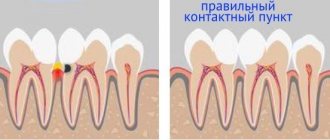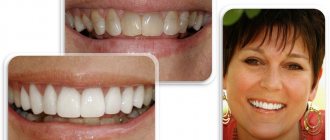Have you had to replace old fillings installed several years ago? Do you know what this threatens?
We will tell you how to avoid frequent replacement of fillings by using another dental restoration technology. In the article Filling, inlay or crown? We reviewed different methods of dental restoration, and today we will tell you in detail about the advantages of inlays .
An inlay is a filling made in a dental laboratory from filling materials, metals or ceramics.
Restoring a tooth with an inlay is more expensive than with a regular filling, and to understand whether it’s worth paying more , let’s figure out why an inlay is better than a filling. The benefits of inlays become obvious if you understand the reasons for replacing old fillings.
Let's start with the functions that the filling performs.
Material shrinkage is one of the reasons for replacing old fillings
Protection of the tooth from infection is ensured by the tightness of the connection at the border of the filling with the tooth tissue. Modern adhesive compounds reliably glue the filling to the tooth, but sometimes this can become a problem.
During curing, any material decreases in volume ( shrinks ) and filling material is no exception. By shrinking, the filling “pulls” on itself the parts of the tooth to which it is securely glued, and if the area of the filling is large, this force may be enough to cause cracks and chips to appear.
secondary caries forms at the site where the filling is torn from the tooth tissue .
Shrinkage of the filling material also poses other problems:
- with vertical shrinkage, the height of the bite changes, which leads to dysfunction of the temporomandibular joint and improper load on the filled tooth. As a result, the tooth may become damaged and require a crown to be installed to restore it.
- shrinkage of the filling horizontally leads to the disappearance of the contact point (point of contact) between adjacent teeth and stuck food puts pressure on the periodontal papilla, injuring it. The gums become inflamed, gingivitis, periodontitis and secondary caries develop.
Sealing
High-quality tooth filling occurs in 40-60 minutes. Root canals are washed using antiseptic agents and filled with sealed material. If the canals have been sealed professionally, then future infection is excluded.
The next step is filling the tooth cavity. The dentist installs the required matrix on it, suitable for the further shape. Then an adhesive (good adhesive) composition is applied and work is done on the future filling. The filling is laid in layers. The final stage involves adjusting the filling to the bite and polishing it.
In order to avoid replacing fillings, you need to carefully monitor your dental hygiene and visit the dentist as often as possible.
What are the consequences of insufficient filling strength?
The technology for making a filling (in the patient’s mouth) does not make it as strong as possible, so over time the filling material wears out.
As in the case of vertical shrinkage, abrasion of the filling can lead to problems:
- the level of bite changes , and this can lead to the chipping of part of the tooth due to the redistribution of the chewing load from the filling to the walls of the tooth.
- the boundary between the filling and the tooth tissue changes , while the filling loses its tightness and the infection penetrating inside provokes the development of secondary caries.
What are permanent dental fillings?
Permanent fillings differ in the material from which they are made. Most of the materials that dentists used to use to put fillings are no longer used today. These are various metal alloys that have become a thing of the past due to their high thermal conductivity (they could cause overheating of the pulp), dentistry has abandoned most plastics due to their toxicity and fragility, many types of cements are not used due to their inability to imitate color and density natural tooth, and also because they required thorough grinding of healthy tissue.
Modern dental fillings are made from composite materials. And here they are presented in two main varieties - chemical and light fillings. The first is so named because it requires a chemical reaction to harden, the second hardens under the influence of a special blue light, which is produced using a dental lamp.
Photos before and after installing a filling on a chewing tooth
Other disadvantages of the filling and reasons for replacing it
- Inaccurate anatomical shape of the tooth.
Restoring the correct shape of a tooth in a patient’s mouth is a difficult task. This work requires the dental therapist to have a good knowledge of anatomy and the skill of a sculptor. But even with these skills, it is difficult to model the shape of a tooth in hard-to-reach places.Inaccurate tooth shape is the cause of malocclusion (especially if there are a lot of fillings). Teeth grind food incorrectly, causing discomfort when biting, headaches appear, teeth are injured in the process of chewing food and are destroyed over time.
- Overhanging edges of the filling.
If, when installing a filling, the material flows onto the gum and rests on it, this leads to permanent injury and inflammation of the gums.A filling installed with such a defect causes local periodontitis and secondary caries, since it is difficult to remove stuck food from the resulting “pocket.”
- Difficulty in thoroughly sanding surfaces .
In places of contact with neighboring teeth, it is impossible to completely get rid of the roughness of the filling, and dental plaque adheres well to such a surface. - Development of caries at the interface between tooth and filling . The gradual shrinkage of the filling material and the destruction of the adhesive connection makes the border between the tooth and the filling the most vulnerable place where secondary caries develops first.
- Changes in the color of the filling material and tooth tissue over time make the border of the filling too noticeable.
What are the complications after installing a filling?
The most common complaint from patients after visiting the dentist is a feeling as if the tooth under the filling hurts. Such sensations are absolutely normal for several hours after treatment (up to 1 day), but if the pain does not subside the next day, this may mean that the doctor made a mistake, for example, did not properly treat the carious cavity before installing a filling. If a day has passed and the tooth still hurts, you need to go to the dentist again, you may have to take an x-ray and, if necessary, re-treat.
Another common reason for visiting a dentist is when a filling has fallen out. As we have already said, these structures have a certain service life, after which they need to be replaced; if this is not done, they can actually fall out. And in such situations, the main thing is to understand why this happened - because the tooth was not treated for a long time, or did secondary caries develop in it? As for fresh fillings, they can only fall out in the event of a medical error. Therefore, choose proven clinics where quality fillings are installed in Moscow.
What does replacing a filling lead to?
What's wrong with changing the filling when needed? The problem is that you don’t know the exact time when the old filling stops performing its functions, but if part of the tooth breaks off, the doctor will be forced to put in a new, larger filling.
In the case of advanced caries and pulpitis, it may be necessary to remove the nerve, but a “dead” tooth is more fragile and fillings and inlays adhere less well to its tissues (which means the service life will be shorter).
We devoted the article Karis to the treatment of different stages of caries: what is it like? And why does treatment differ so much in price? Read it to understand how caries progresses.
With each filling replacement, the “native” tooth becomes smaller and the moment approaches when it can only be restored with a crown.
How does the replacement take place?
Many patients are worried: is it painful to change a filling? The procedure is performed under local anesthesia and is therefore absolutely painless.
In general terms, re-sealing occurs as follows:
- anesthesia is administered
- the desired tooth is isolated from the oral cavity with a rubber dam: so that moisture and microorganisms do not enter the treated cavity,
- old filling material and tissues affected by caries (if any) are removed
- the cavity is treated with a special etching solution and dried,
- an insulating or medicinal pad is applied,
- a new filling is applied.
Restoration takes place with mandatory consideration of the anatomical features of the chewing surface.
Why is a ceramic inlay better than a regular filling?
Unlike a filling, which a doctor makes in the mouth, an inlay goes through all stages of manufacturing in a dental laboratory. The dentist only processes the tooth cavity under the inlay and makes impressions of the jaws, and after making the inlay, glues it in place.
Restoring a tooth with an inlay requires two visits to the dentist, but ensures long-term functionality and aesthetic perfection of the restoration.
Advantages of ceramic inlays:
- Inlays do not shrink after placement because this process is completed during the manufacturing stage in the dental laboratory.
- Ceramic inlays have the highest strength and do not wear out over time, thanks to production technology. The inlay is pressed from a ceramic mass heated to high temperatures or machined from a single piece of ceramic.
- Inlays completely restore the anatomical shape of the tooth and chewing functions, thanks to the modeling of the bite in the articulator using casts of two jaws.
- Making an inlay with fitting on a plaster model makes it possible to create it without overhanging edges , restore tooth defects in hard-to-reach places, ensure correct interdental contact and good marginal fit of the inlay to the tooth. All this is difficult to do when making a filling in the oral cavity.
- All outer surfaces of the inlay (including those in contact with adjacent teeth) are perfectly ground before installation.
- It is easier to select the desired color and translucency of the inlay in the laboratory than in the patient’s mouth. Therefore, ceramic inlays are the best option for aesthetic dental restoration.
- The inlay is more reliably glued to the tooth, since the doctor requires a minimum of time to install an inlay of exactly the right size into the treated tooth cavity (due to the speed of installation, the risk of moisture and infection on the treated surfaces is reduced).
By restoring a tooth with a ceramic inlay, you get a high-quality, durable restoration and do not get tired during the appointment, since you do not need to sit for a long time with your mouth open.
For medical reasons, if the coronal part of the tooth is destroyed by more than 30%, it is recommended to install an inlay.
Modern filling materials
In modern dentistry, a new generation of light-polymer materials is used, which have replaced the old cement, acrylic, and amalgam fillings. Their characteristic features are:
- high degree of strength;
- long service life;
- excellent aesthetic indicators;
- strong adhesive adhesion;
- Can be used on all teeth.
New generation fillings
Zinc phosphate, glass ionomer zinc eugenol filling cements differ from previously produced ones:
- increased strength;
- wear resistance;
- high aesthetic indicators.
Composite and ceramic inlays
They are made from individual impressions, which the doctor takes from the patient’s teeth. Inlays are used when more than 50% of the tooth is damaged. They can be restorative and stump. The first ones are used to restore the shape of the tooth, the second ones are used for further installation of crowns on them.
Crowns
In cases where simply replacing the filling is no longer enough, crowns are used. We can say that the crown is the last line on the path of tooth destruction. The next step is the removal and subsequent installation of a bridge, which threatens the integrity of the adjacent dental units, which are to be ground and serve as a support for the prosthesis, or the implantation of a titanium root.
To avoid giving dental caries and related diseases a chance, don’t forget to periodically make an appointment with your dentist. At the Plomba family dentistry clinic, you will be treated by specialists with many years of experience who have modern materials and technologies at their disposal.
Types of ceramic inlays
- inlay tab - restores the “cavities” of the tooth crown
- onlay tab - restores most of the chewing surface of the tooth crown
- overlay tab - restores the chewing surface and side walls of the tooth crown
The service life of the inlays is more than 10 years, while the filling will require replacement after an average of 5 years.
Now, when a dentist suggests restoring a tooth with an inlay, you know what benefits this will provide in the future.
Pastes
Almost all types of pastes can be easily removed using a regular solvent. First, using Girdwood burs and long round burs, and then Hedström files or new reamers, the filling is removed. If removal occurs from the canals, then it is necessary to know exactly the length of the tooth, which is done using x-rays. It is also necessary to irrigate the canal frequently to remove any sawdust that appears.
After the filling is removed, it must be replaced with a new one. The most common of them are a light (light-polymer) filling, which is most often installed on the front part of the teeth, a cement filling (zinc phosphate, glass ionomer, zinc eugenol), as well as an inlay.










